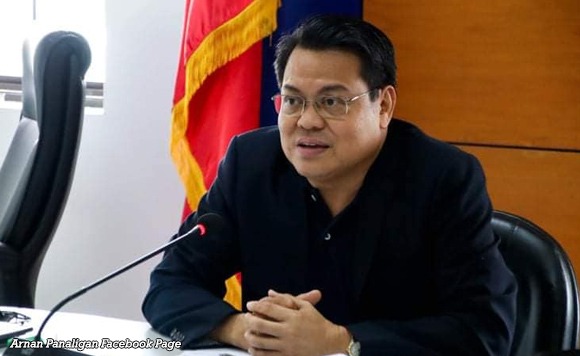Congressman Arnan Panaligan and the Flood Control Controversy
This investigative piece looks into Congressman Arnan Panaligan and his link to billions in flood control projects exposed in Senator Ping Lacson’s privilege speech. It traces how Panaligan’s office publicly claimed ownership of projects on Facebook, how two major flood control works were tied to unprogrammed appropriations, and why several newly built structures collapsed within months. The article explores Panaligan’s defense, DPWH’s role, and the systemic flaws in congressional insertions and project implementation that blur the lines between political credit and accountability.


He was mentioned in Senator Ping Lacson’s privilege speech. Not by name, but enough clues were there.
That got me curious.
On August 20, 2025, Lacson stood before the Senate and talked about billions poured into flood control projects in Oriental Mindoro. He didn’t spell out the lawmaker’s name, but his slide presentation did. The banners, the “AGILA” branding, and an accomplishment report covering June 30, 2022 to December 31, 2023 all pointed to one man: Oriental Mindoro 1st District Representative Arnan Capulong Panaligan.
Who is Arnan Panaligan?
Panaligan isn’t new to politics. Born January 21, 1962 in Calapan, he studied at Holy Infant Academy, took up law at Ateneo de Manila, and passed the bar in 1987. He began his career as a Supreme Court researcher and later worked at the House of Representatives Electoral Tribunal.
His political track record is long. He served as mayor of Calapan from 1995 to 2004 and again from 2013 to 2022. He was governor of Oriental Mindoro from 2004 to 2010 after the death of Governor Bartolome Marasigan. In 2022, he became congressman for the province’s first district.
In 2021, he ranked third nationwide in mayoral job approval ratings, a recognition of his visibility and local support. Today, he holds the post of House Deputy Majority Leader and was one of the eleven prosecutors in the impeachment trial of Vice President Sara Duterte in February 2025.
On paper, his career looks steady. Which makes Lacson’s allegations sting deeper.
The Allegations
Lacson said Panaligan’s office was tied to billions in flood control projects. The numbers were staggering: ₱3.6 billion for Naujan, ₱807 million for Baco, and a combined total of more than ₱4.4 billion in just two municipalities.
The evidence Lacson showed wasn’t buried in government ledgers. It was on Facebook. Panaligan’s own accomplishment report carried the AGILA banner—Aksyon ng Gobyerno at Inisyatibo sa Larangang Lehislatura—and listed the projects as “funded by his office.” At project sites, physical banners carried the same claim of ownership.
Among the many projects, two stood out: the ₱95-million flood control structure in Barangay Burbuli, Baco, awarded to Silverwolves Construction Corporation, and the ₱231-million Butas River project in Naujan, awarded to Rayman Builders.
Why Lacson Called Some Projects “Unprogrammed”
The Facebook posts were one thing. They showed Panaligan publicly claiming the projects. But the funding trail told a different story.
Lacson revealed that the Burbuli and Butas River projects were not part of the regular budget. They were drawn from unprogrammed appropriations of the 2024 national budget.
Unprogrammed appropriations are standby funds. They aren’t guaranteed like programmed appropriations, which already have identified funding sources. They can only be released under specific conditions: when the government collects more revenue than expected, when new funding sources come in, when grants are secured, or when approved loans become available. DBM itself describes them as “standby authority” that requires certification before the money can move.
Accessing these funds is supposed to be complicated. Lacson described the process as masalimuot—long and difficult—yet here were two flood control projects from Panaligan’s district that had managed to secure them. This was why Lacson remarked: “Napakalakas naman po yata ni Congressman.”
The trail showed that these projects were not in the original National Expenditure Program submitted by the executive branch. They surfaced during budget deliberations in Congress. The House expanded the executive’s proposed ₱158.67 billion unprogrammed fund to over ₱531 billion in the 2024 General Appropriations Act.
In Barangay Mulawin alone, ₱1.9 billion was allocated for eight flood control projects. Only ₱810 million was part of the original executive proposal. The remaining ₱1.1 billion appeared later in the House version.
This was what Lacson meant when he said projects “sprouted like mushrooms.” For him, insertions weren’t faceless entries in a spreadsheet—they had political owners. And when those owners put their names on banners or reports, they also took responsibility for how the money was spent.
Evidence of Failures
Numbers alone don’t prove corruption. But the state of the projects spoke for themselves.
In August 2025, nine newly built flood control projects collapsed during the monsoon rains. Drone footage showed cracks and defects in structures that should have been new. In Barangay Mulawin, where ₱1.9 billion had been poured in, some dikes were reportedly filled with sand instead of proper gravel and cement. Sheet piles were installed too shallow, making them unstable.
Some of the projects completed in February 2025 didn’t even last three months before giving way. Governor Humerlito Dolor named the contractors responsible, putting more pressure on DPWH and those tied to the contracts.
Patterns in the budget added to suspicions. Several projects carried identical contract amounts—₱77.199 million—suggesting manipulation in pricing.
Panaligan’s Defense
Faced with the allegations, Panaligan distanced himself from the failures. He said it was DPWH, not his office, that proposed and implemented the projects.
He pointed out that the projects had already been included in the National Expenditure Program when it reached Congress. Lawmakers approve budgets, but they don’t handle bidding, awarding of contracts, or project implementation. All of that, he stressed, is the responsibility of DPWH.
He added that the contractors were regional or national firms, not from Oriental Mindoro. And in July 2024, he had even written to Public Works Secretary Manuel Bonoan, complaining about damaged flood control projects and asking for repairs.
To him, if the projects were anomalous, the fault lay with DPWH’s planning and oversight—not with his office.
Assessing the Case
Lacson’s evidence was hard to ignore. Banners, social media posts, project records, drone footage, and even witness accounts tied Panaligan’s name to the flood control works. The funding trail showed insertions and the use of unprogrammed appropriations.
But there were gaps. Nothing in the documents proved that Panaligan personally profited. No record showed him meddling with the bidding or selecting contractors. His explanation of how the budget process works—the NEP to the General Appropriations Act—was procedurally correct. And politicians taking credit for projects in their districts, even those they didn’t technically implement, is a common practice.
That leaves the case in a gray area. The evidence makes him politically accountable but doesn’t yet amount to legal guilt.
Institutional Actions
The issue didn’t end with Lacson’s speech. DPWH moved quickly, relieving engineers and staff tied to the collapsed projects. Investigations into contractors began.
President Marcos also weighed in. He launched the sumbongsapangulo website, encouraging citizens to report anomalous projects. He noted the broader pattern of flood control contracting nationwide, suggesting that what happened in Oriental Mindoro wasn’t an isolated case but part of a deeper problem.
The Bigger Picture
At its heart, this controversy isn’t just about one congressman. It exposes a system that allows politicians to claim ownership when things go right but escape accountability when they go wrong.
Congressional insertions make it possible to attach billions in projects during budget deliberations. DPWH’s weak oversight lets substandard work pass. Contractor collusion keeps contract amounts suspiciously uniform. And the secrecy of the bicameral committee means no one really knows who inserted what into the budget.
In that kind of environment, Panaligan’s case becomes a symbol. He may or may not have broken the law, but his name ended up tied to projects that collapsed and billions that disappeared into concrete walls that couldn’t withstand a single season of rain.
Conclusion
The flood control projects in Oriental Mindoro were real. The money was real. So were the failures.
Panaligan’s name and office were publicly linked to them, through Facebook posts, accomplishment reports, and banners. But the funding mechanism—the use of unprogrammed appropriations—revealed how much of this controversy is rooted in a flawed system rather than one man alone.
So, was Lacson right to mention him in that privilege speech? Yes. Because even if the courts never find evidence of criminal liability, the public already saw where the money went and what little it achieved. And in politics, sometimes that’s enough to cast a shadow that no privilege speech can erase.
Sources
Contact us
subscribe to morning coffee thoughts today!
inquiry@morningcoffeethoughts.org
© 2024. All rights reserved.
